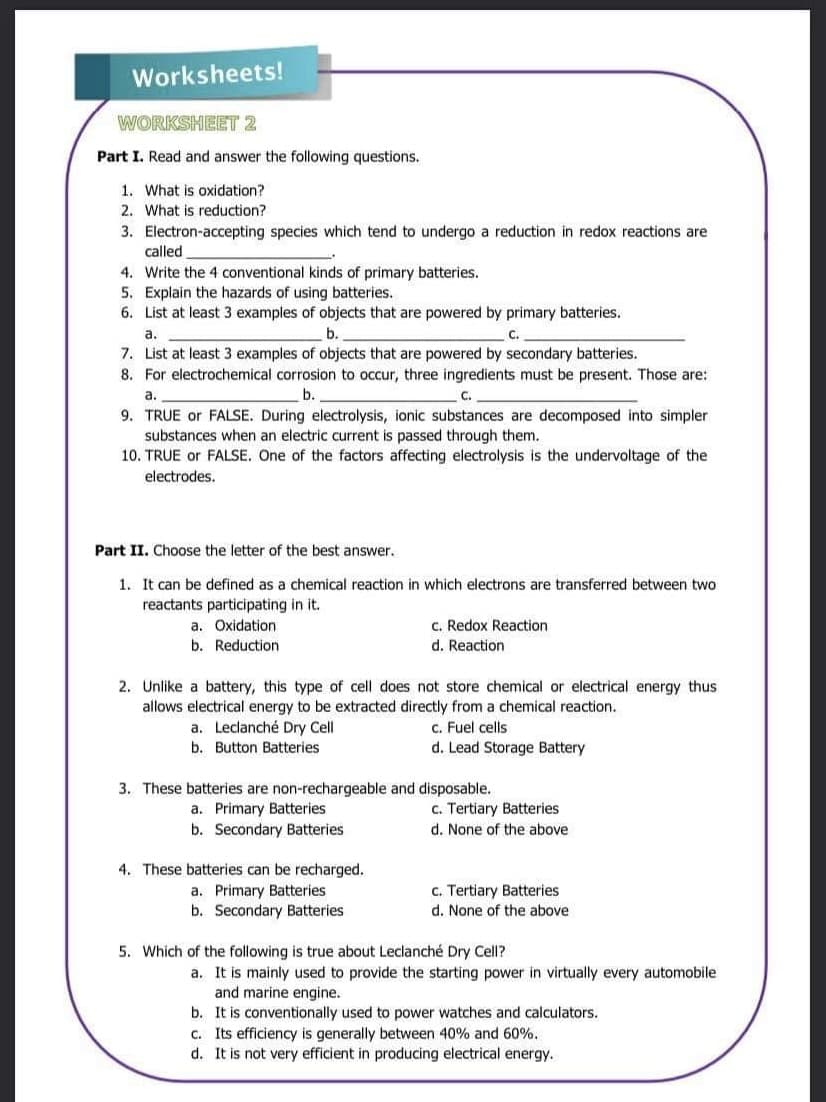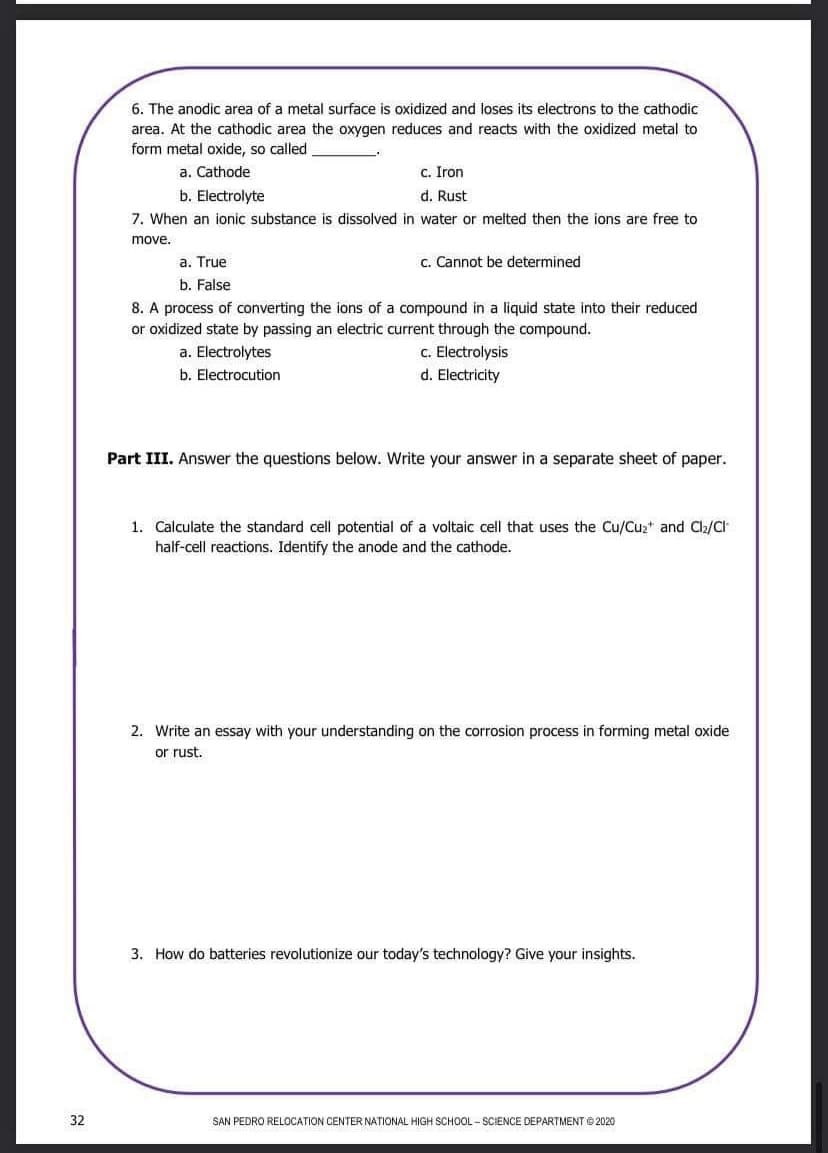Chemistry for Engineering Students
4th Edition
ISBN:9781337398909
Author:Lawrence S. Brown, Tom Holme
Publisher:Lawrence S. Brown, Tom Holme
Chapter13: Electrochemistry
Section: Chapter Questions
Problem 13.57PAE
Related questions
Question

Transcribed Image Text:Worksheets!
WORKSHEET 2
Part I. Read and answer the following questions.
1. What is oxidation?
2. What is reduction?
3. Electron-accepting species which tend to undergo a reduction in redox reactions are
called
4. Write the 4 conventional kinds of primary batteries.
5. Explain the hazards of using batteries.
6. List at least 3 examples of objects that are powered by primary batteries.
C.
a.
b.
7. List at least 3 examples of objects that are powered by secondary batteries.
8. For electrochemical corrosion to occur, three ingredients must be present. Those are:
b.
a.
C.
9. TRUE or FALSE. During electrolysis, ionic substances are decomposed into simpler.
substances when an electric current is passed through them.
10. TRUE or FALSE. One of the factors affecting electrolysis is the undervoltage of the
electrodes.
Part II. Choose the letter of the best answer.
1. It can be defined as a chemical reaction in which electrons are transferred between two
reactants participating in it.
a. Oxidation
b. Reduction
2. Unlike a battery, this type of cell does not store chemical or electrical energy thus
allows electrical energy to be extracted directly from a chemical reaction.
a. Leclanché Dry Cell
c. Fuel cells
b. Button Batteries
d. Lead Storage Battery
c. Redox Reaction
d. Reaction
3. These batteries are non-rechargeable and disposable.
a. Primary Batteries
b. Secondary Batteries
4. These batteries can be recharged.
a. Primary Batteries
b. Secondary Batteries
c. Tertiary Batteries
d. None of the above
c. Tertiary Batteries
d. None of the above
5. Which of the following is true about Leclanché Dry Cell?
a. It is mainly used to provide the starting power in virtually every automobile
and marine engine.
b. It is conventionally used to power watches and calculators.
c. Its efficiency is generally between 40% and 60%.
d. It is not very efficient in producing electrical energy.

Transcribed Image Text:32
6. The anodic area of a metal surface is oxidized and loses its electrons to the cathodic
area. At the cathodic area the oxygen reduces and reacts with the oxidized metal to
form metal oxide, so called
a. Cathode
c. Iron
d. Rust
b. Electrolyte
7. When an ionic substance is dissolved in water or melted then the ions are free to
move.
a. True
b. False
8. A process of converting the ions of a compound in a liquid state into their reduced
or oxidized state by passing an electric current through the compound.
c. Cannot be determined
a. Electrolytes
b. Electrocution
c. Electrolysis
d. Electricity
Part III. Answer the questions below. Write your answer in a separate sheet of paper.
1. Calculate the standard cell potential of a voltaic cell that uses the Cu/Cu₂+ and Cl₂/Cl
half-cell reactions. Identify the anode and the cathode.
2. Write an essay with your understanding on the corrosion process in forming metal oxide
or rust.
3. How do batteries revolutionize our today's technology? Give your insights.
SAN PEDRO RELOCATION CENTER NATIONAL HIGH SCHOOL-SCIENCE DEPARTMENT Ⓒ2020
Expert Solution
This question has been solved!
Explore an expertly crafted, step-by-step solution for a thorough understanding of key concepts.
Step by step
Solved in 4 steps with 1 images

Knowledge Booster
Learn more about
Need a deep-dive on the concept behind this application? Look no further. Learn more about this topic, chemistry and related others by exploring similar questions and additional content below.Recommended textbooks for you

Chemistry for Engineering Students
Chemistry
ISBN:
9781337398909
Author:
Lawrence S. Brown, Tom Holme
Publisher:
Cengage Learning

Chemistry: An Atoms First Approach
Chemistry
ISBN:
9781305079243
Author:
Steven S. Zumdahl, Susan A. Zumdahl
Publisher:
Cengage Learning


Chemistry for Engineering Students
Chemistry
ISBN:
9781337398909
Author:
Lawrence S. Brown, Tom Holme
Publisher:
Cengage Learning

Chemistry: An Atoms First Approach
Chemistry
ISBN:
9781305079243
Author:
Steven S. Zumdahl, Susan A. Zumdahl
Publisher:
Cengage Learning


Chemistry
Chemistry
ISBN:
9781305957404
Author:
Steven S. Zumdahl, Susan A. Zumdahl, Donald J. DeCoste
Publisher:
Cengage Learning

Chemical Principles in the Laboratory
Chemistry
ISBN:
9781305264434
Author:
Emil Slowinski, Wayne C. Wolsey, Robert Rossi
Publisher:
Brooks Cole

Chemistry: Principles and Practice
Chemistry
ISBN:
9780534420123
Author:
Daniel L. Reger, Scott R. Goode, David W. Ball, Edward Mercer
Publisher:
Cengage Learning